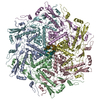+Search query
-Structure paper
| Title | Structure and Function of Hoc-A Novel Environment Sensing Device Encoded by T4 and Other Bacteriophages. |
|---|---|
| Journal, issue, pages | Viruses, Vol. 15, Issue 7, Year 2023 |
| Publish date | Jul 7, 2023 |
 Authors Authors | Andrei Fokine / Mohammad Zahidul Islam / Qianglin Fang / Zhenguo Chen / Lei Sun / Venigalla B Rao /   |
| PubMed Abstract | Bacteriophage T4 is decorated with 155 180 Å-long fibers of the highly antigenic outer capsid protein (Hoc). In this study, we describe a near-atomic structural model of Hoc by combining cryo- ...Bacteriophage T4 is decorated with 155 180 Å-long fibers of the highly antigenic outer capsid protein (Hoc). In this study, we describe a near-atomic structural model of Hoc by combining cryo-electron microscopy and AlphaFold structure predictions. It consists of a conserved C-terminal capsid-binding domain attached to a string of three variable immunoglobulin (Ig)-like domains, an architecture well-preserved in hundreds of Hoc molecules found in phage genomes. Each T4-Hoc fiber attaches randomly to the center of gp23* hexameric capsomers in one of the six possible orientations, though at the vertex-proximal hexamers that deviate from 6-fold symmetry, Hoc binds in two preferred orientations related by 180° rotation. Remarkably, each Hoc fiber binds to all six subunits of the capsomer, though the interactions are greatest with three of the subunits, resulting in the off-centered attachment of the C-domain. Biochemical analyses suggest that the acidic Hoc fiber (pI, ~4-5) allows for the clustering of virions in acidic pH and dispersion in neutral/alkaline pH. Hoc appears to have evolved as a sensing device that allows the phage to navigate its movements through reversible clustering-dispersion transitions so that it reaches its destination, the host bacterium, and persists in various ecological niches such as the human/mammalian gut. |
 External links External links |  Viruses / Viruses /  PubMed:37515203 / PubMed:37515203 /  PubMed Central PubMed Central |
| Methods | EM (single particle) |
| Resolution | 3.3 - 3.4 Å |
| Structure data |  PDB-8t1x:  PDB-8t9r: |
| Source |
|
 Keywords Keywords |  VIRAL PROTEIN / VIRAL PROTEIN /  bacteriophage / bacteriophage /  capsid / T4 head / Hoc / highly immunogenic outer capsid protein / virus decoration protein / immunoglobulin-like domains / antigen display / capsid / T4 head / Hoc / highly immunogenic outer capsid protein / virus decoration protein / immunoglobulin-like domains / antigen display /  vaccine vaccine |
 Movie
Movie Controller
Controller Structure viewers
Structure viewers About Yorodumi Papers
About Yorodumi Papers




